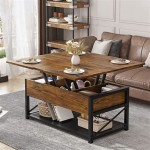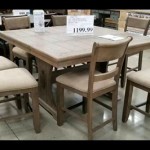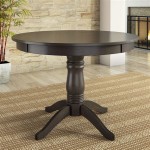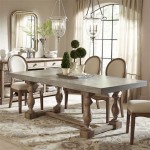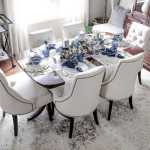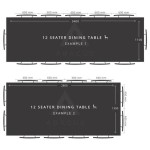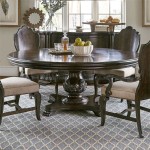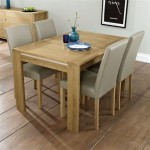Kitchen Dining Table and Chair Set: A Comprehensive Guide
The kitchen dining table and chair set represents a cornerstone of the modern home. Functioning as a nexus for culinary creation and social interaction, the selection of an appropriate set requires careful consideration of factors encompassing space, style, materials, and functionality. This article provides a detailed examination of the various aspects involved in choosing the ideal kitchen dining table and chair set, aiming to equip readers with the knowledge necessary to make an informed decision.
Understanding Space Constraints
Before embarking on the selection process, a precise assessment of the available space is paramount. Accurate measurements of the kitchen or dining area will dictate the maximum dimensions of the table and the optimal number of chairs that can be comfortably accommodated. Consider the following during the measurement process:
The first stepin determining space is to measure the length and width of the area where the dining set will be placed. This provides the boundaries within which the set must fit. Ensure the measurements are accurate, accounting for intrusions such as doorways, windowsills, and permanent fixtures.
Beyond the table itself, allow for adequate clearance around the table for comfortable movement. A minimum of 36 inches, and ideally 48 inches, should be maintained between the edge of the table and any walls or obstructions. This clearance ensures that individuals can easily pull out chairs and navigate around the table without hindrance. This allowance impacts the maximum table size that the space can effectively accommodate.
Consider the potential for expansion. If the table includes leaves or extendable sections, factor in the space required when the table is fully extended. This is particularly important for accommodating larger gatherings or special occasions. This extension potential may significantly impact the usable space within the room.
The shape of the room will also influence the table shape selection. A square or rectangular room might best accommodate a rectangular or square table, while a round table could be more suitable for a smaller or more awkwardly shaped space. Analyze the room's architecture to determine the shape that maximizes space utilization and optimizes traffic flow.
Once the measurements are acquired, create a scaled floor plan using graph paper or digital tools. This visual representation will assist in visualizing different table sizes and configurations within the available space. Experiment with different layouts to determine the most efficient and aesthetically pleasing arrangement.
Navigating Style Considerations
The aesthetic appeal of the kitchen dining table and chair set should complement the existing décor and reflect the homeowner's personal style. A wide range of styles are available, each characterized by distinct features and materials. Some of the most popular style options include:
Traditional: Traditional dining sets typically feature ornate details, elaborate carvings, and rich finishes, often incorporating dark woods like mahogany or cherry. Chairs may be upholstered with luxurious fabrics like velvet or brocade. This style lends an air of formality and sophistication to the dining area.
Modern: Modern dining sets often prioritize clean lines, minimalist designs, and geometric shapes. Materials commonly used include glass, metal, and engineered wood. Chairs may feature sleek silhouettes and neutral color palettes. This style promotes a sense of spaciousness and uncluttered elegance.
Contemporary: Contemporary dining sets blend elements from both traditional and modern styles, creating a balanced and eclectic aesthetic. They may incorporate a mix of materials, such as wood and metal, and feature unique design details that reflect current trends. Color palettes are often bolder and more adventurous than those found in strictly modern settings.
Rustic: Rustic dining sets embrace natural materials, such as reclaimed wood and exposed metal. They often feature distressed finishes and rugged textures, evoking a sense of warmth and authenticity. Chairs may be crafted from wood or feature woven seats. This style lends a cozy and inviting atmosphere to the dining area.
Farmhouse: Farmhouse dining sets share similarities with rustic styles but often incorporate lighter colors and more delicate details. They may feature painted wood finishes, Shaker-style chairs, and simple, unadorned designs. This style creates a charming and welcoming ambiance.
Industrial: Industrial dining sets draw inspiration from factories and warehouses, incorporating raw materials like metal and concrete. They may feature exposed rivets, distressed finishes, and minimalist designs. Chairs often have metal frames and wooden seats. This style offers a bold and edgy aesthetic.
When selecting a style, consider the overall aesthetic of the kitchen or dining area. A cohesive design will create a harmonious and visually appealing space. Consider factors such as wall color, flooring, lighting, and existing furniture when making your selection. It is also crucial to consider your own personal preferences and lifestyle. Choose a style that reflects your taste and complements your daily routines.
Evaluating Material Options
The materials used in the construction of a kitchen dining table and chair set significantly impact its durability, aesthetics, and maintenance requirements. A thorough understanding of the properties of different materials is essential for making an informed decision.
Wood: Wood remains a popular choice for dining table and chair sets due to its inherent warmth, versatility, and durability. Different types of wood offer varying levels of hardness, grain patterns, and color variations. Hardwoods like oak, maple, and cherry are known for their strength and resistance to wear. Softwoods like pine and cedar are more affordable but may be more susceptible to dents and scratches. Wood tables require regular cleaning and polishing to maintain their beauty, and they may be susceptible to damage from moisture and heat.
Glass: Glass dining tables offer a sleek and modern aesthetic, creating a sense of spaciousness and light. Tempered glass is the preferred option due to its strength and resistance to shattering. Glass tables are easy to clean and maintain, but they may show fingerprints and require frequent wiping. They can also be more susceptible to scratches than wood or metal tables. Glass tables are often paired with metal or wooden legs for added stability and style.
Metal: Metal dining tables and chairs offer durability, strength, and a contemporary aesthetic. Stainless steel, wrought iron, and aluminum are common materials used in metal furniture. Metal tables are easy to clean and maintain, and they are resistant to moisture and heat. However, they can be cold to the touch and may lack the warmth and character of wood. Metal chairs may be uncomfortable without cushions or upholstery.
Stone: Stone dining tables, typically made of marble or granite, offer a luxurious and durable option. These tables are highly resistant to heat, scratches, and stains, making them ideal for heavy use. However, stone tables are heavy and can be difficult to move. They also require specialized cleaning and sealing to prevent damage. Stone tables are often expensive and may not be suitable for all budgets.
Engineered Wood: Engineered wood, such as plywood and MDF, offers an affordable and versatile alternative to solid wood. These materials are made by bonding wood fibers together with adhesives. Engineered wood is less expensive than solid wood, but it may not be as durable or long-lasting. It is also more susceptible to damage from moisture. Engineered wood tables often feature veneers or laminates to mimic the appearance of solid wood.
In addition to the table material, consider the material used for the chair seats and backs. Options include wood, upholstery, and woven materials. Upholstered chairs offer comfort and style, but they require regular cleaning and may be susceptible to stains. Woven chairs, such as those made from rattan or wicker, offer a natural and textured look.
Analyzing Chair Types and Ergonomics
The selection of chairs is as important as the table itself. Beyond aesthetics, the chairs should provide adequate support and comfort for prolonged use. Ergonomic considerations should be prioritized to promote good posture and minimize discomfort. Different chair types offer varying levels of comfort and support:
Side Chairs: Side chairs are armless chairs that typically feature a simple design. They are versatile and can be used in a variety of settings. However, they may not provide as much support as chairs with arms.
Arm Chairs: Arm chairs feature armrests that provide additional support and comfort. They are often used at the head of the table or as accent chairs. Arm chairs may take up more space than side chairs.
Parsons Chairs: Parsons chairs are upholstered chairs with a high back and straight lines. They offer a formal and elegant look and provide excellent comfort. Parsons chairs can be expensive and may require specialized cleaning.
Benches: Benches offer a casual and space-saving seating option. They can accommodate multiple people and are ideal for informal dining areas. However, benches may not provide as much support as individual chairs.
Stools: Stools are typically used at kitchen islands or breakfast bars. They come in a variety of heights and styles. Bar stools are taller than counter stools and are designed for use at raised surfaces. Stools may or may not have backs or armrests.
When selecting chairs, consider the seat height, back support, and armrest height. The seat height should be appropriate for the table height, allowing for comfortable legroom. The back support should provide adequate lumbar support to promote good posture. The armrest height should allow for comfortable arm positioning. Test out the chairs before purchasing to ensure they provide adequate comfort and support.
Consider the upholstery material, if applicable. Options include fabric, leather, and vinyl. Fabric upholstery offers a wide range of colors and patterns but may be susceptible to stains. Leather upholstery is durable and easy to clean but can be expensive. Vinyl upholstery is water-resistant and easy to clean, making it a practical choice for families with children.
Considering Shape and Size Dynamics
The shape and size of the kitchen dining table are crucial considerations, influencing both the functionality and aesthetics of the dining area. Common table shapes include rectangular, square, round, and oval, each offering distinct advantages and disadvantages.
Rectangular Tables: Rectangular tables are the most common type of dining table, offering versatility and ample seating space. They are ideal for larger dining areas and can accommodate a significant number of people. Rectangular tables work well in rectangular rooms and provide a formal and symmetrical look. However, they may not be suitable for smaller spaces as they can dominate the room.
Square Tables: Square tables are well-suited for smaller dining areas and offer a cozy and intimate setting. They are ideal for seating four people and promote conversation. Square tables work well in square rooms and create a balanced and symmetrical look. However, they may not be suitable for larger gatherings.
Round Tables: Round tables create a sense of intimacy and encourage conversation. They are ideal for smaller dining areas and can accommodate a flexible number of people. Round tables work well in a variety of room shapes and promote a feeling of openness. However, they may not provide as much surface area as rectangular tables.
Oval Tables: Oval tables offer a compromise between rectangular and round tables, providing both ample seating space and a sense of intimacy. They are ideal for medium-sized dining areas and can accommodate a flexible number of people. Oval tables work well in a variety of room shapes and offer a softer and more organic look than rectangular tables. However, they may be more expensive than other table shapes.
The size of the table should be proportional to the size of the room. A large table in a small room will feel overwhelming, while a small table in a large room will feel insignificant. Consider the number of people you typically seat for meals and choose a table size that can comfortably accommodate them. Allow for adequate space around the table for comfortable movement and seating.
Weight Capacity Considerations
An often overlooked but crucial aspect of selecting a kitchen dining table and chair set is the weight capacity of both the table and the chairs. Understanding and adhering to these limits is essential for ensuring the safety and longevity of the furniture. Exceeding the weight capacity can lead to structural damage, instability, and potential accidents.
For the table, the weight capacity refers to the maximum amount of weight it can safely support without risk of collapse or damage. This capacity is determined by factors such as the table's material, construction, and leg design. Solid wood tables generally have higher weight capacities than tables made from engineered wood or glass. Tables with sturdy, well-braced legs can support more weight than those with flimsy or poorly designed legs. The table manufacturer's specifications should clearly state the weight capacity. If this information is not readily available, it is advisable to contact the manufacturer or retailer directly for clarification.
Similarly, chairs have weight capacities that must be considered. The weight capacity of a chair is determined by its material, frame construction, and leg design. Chairs made from solid wood or metal typically have higher weight capacities than those made from plastic or lightweight materials. Chairs with reinforced frames and sturdy legs can support more weight than those with flimsy or poorly constructed frames. The chair manufacturer's specifications should also state the weight capacity. It is essential to choose chairs that can comfortably accommodate the weight of all potential users.
It is crucial to remember that the weight capacity is a limit, not a suggestion. Exceeding this limit can compromise the structural integrity of the furniture and lead to safety hazards. Over time, exceeding the weight capacity can cause the table or chairs to warp, crack, or even collapse. This can result in damage to the furniture itself, as well as potential injuries to individuals using it.
Budget Allocation
The price range for kitchen dining table and chair sets can vary significantly depending on factors such as materials, design, brand, and retailer. Establishing a realistic budget prior to beginning the selection process is crucial for narrowing down the options and avoiding overspending. Consider the following:
The first step is to determine the maximum amount you are willing to spend on the entire set. This will serve as a ceiling for your spending and help you focus on options within your price range. Consider your financial situation and allocate a budget that is comfortable and sustainable.
Research the going rates for different types of kitchen dining table and chair sets. Compare prices from various retailers, both online and in brick-and-mortar stores. This research will give you a sense of the average costs for the styles and materials you are interested in. Factor in any additional costs, such as delivery fees, assembly charges, or warranty options. These costs can add up and should be included in your overall budget.
Within your overall budget, allocate specific amounts for the table and the chairs. This will help you prioritize your spending and ensure that you do not overspend on one component at the expense of the other. Consider the relative importance of the table and chairs to your overall dining experience when allocating your budget.
Be prepared for the possibility of additional expenses. You may need to purchase accessories such as tablecloths, placemats, or chair cushions. These items can enhance the aesthetic appeal and comfort of your dining set, but they should be factored into your overall budget.
While it's important to adhere to your budget, consider investing in higher-quality materials and construction if possible. A well-made dining set will last longer and provide better value in the long run. Look for sets that are made from solid wood, durable metal, or high-quality upholstery. These materials may cost more upfront, but they will withstand wear and tear and provide years of enjoyment.

Natural Cherry 6 Piece Kitchen Dining Table Set Wooden Rectangular 4 Fabric Chairs And Bench For Family Ec Dtsnc 6224 The Home

Seg Modern 7 Piece Dining Set With Rectangular Table 6 Upholstered Chairs Ideal For Home B1464

Vecelo 5 Piece Dining Table Set Rectangular Kitchen Chairs W Metal Frame 1 4

Small Natural Wooden Dining Table And 4 Chairs Set Kitchen Room Rustic Pine

Wood Dining Table The Lyla Farmhouse Kitchen Set With Stools Or Benches Etsy

Awqm 5 Piece Dinning Room Table Set Glass Kitchen With 4 Pu Leather Chairs White Dining Of For

Best Choice S 3 Piece Modern Oval Dining Table Set Small Kitchen Dinette W 2 Chairs Medium Brown Black
Newport 9 Piece Dining Table Set Costco

5 Piece Espresso Kitchen Dining Table Set Wood And 4 Chairs For Room

Kara Brown Wood Mid Century Modern Rectangular 60 Kitchen Dining Table Set For 4

